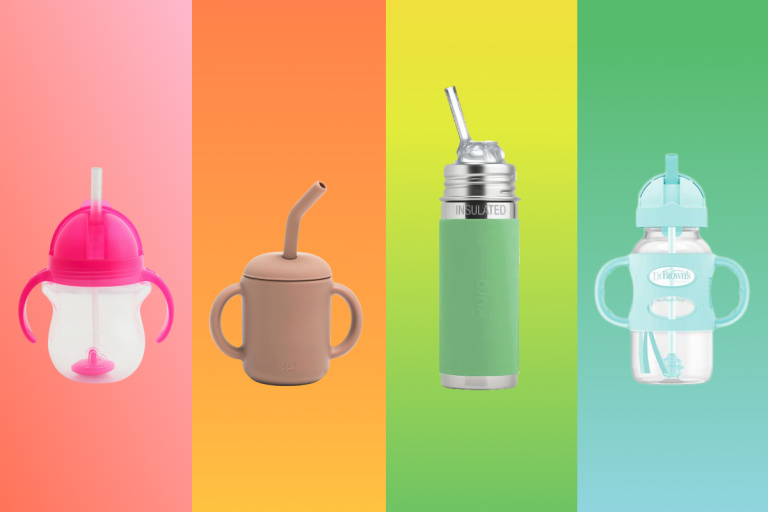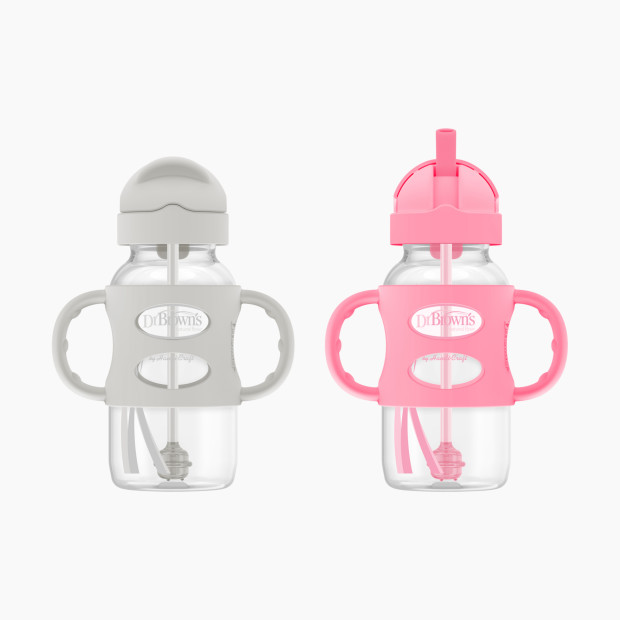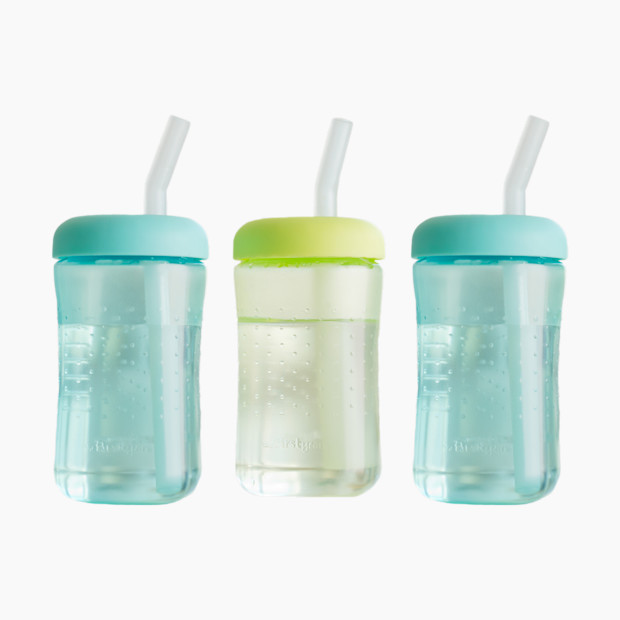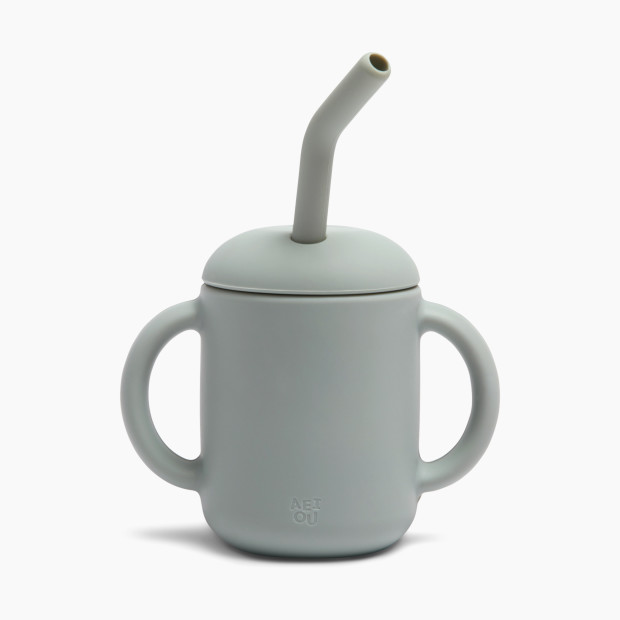
The Best Sippy Cups to Help Transition Babies and Toddlers
These not-so-average sippy cups are baby, parent and expert-approved.

By Briana Engelbrecht and Jen LaBracio, CPST
Fact Checked by Shannon Vestal Robson
In This Article
Learning to drink from a cup is a major milestone in your baby's first year. It’s an exciting step in their development and the start of their solid food journey. But with so many cup options out there, making the transition from bottle or breast to an open, straw or sippy cup can feel overwhelming. You want something that’s just the right size for little hands to hold, easy to clean and appropriate for their oral development (especially when all those tiny teeth start popping up). And in recent years, there’s been a change in what experts say is the ideal first cup for little ones is shifting away from those classic spout sippy cups. We’re here to help you figure it all out.
We didn't choose a best cup overall for this guide because every baby and their individual needs and development are unique. Instead, we looked at different things like leak- and spill-proof features, straws that are beginner friendly and cups that are perfectly sized for tiny hands. Babies are also known to have strong opinions, so we gathered a few more options at the end of this guide to help you find the perfect cup for your little one.
- Best for Beginners
 Dr. Brown's Wide-Neck Sippy Straw Bottle with Silicone Handles (2 Pack) - Gray & Pink, 9 Oz, 2From $7.89
Dr. Brown's Wide-Neck Sippy Straw Bottle with Silicone Handles (2 Pack) - Gray & Pink, 9 Oz, 2From $7.89
Why Trust Babylist?
Babylist is the expert in baby; we know baby gear inside and out. We talk with parents face-to-face in our showroom and on our user panels and hear from thousands annually via our Best Baby Products online survey. We know what items millions of expecting parents are adding to their baby registries.
Firsthand professional and personal experience. As Babylist’s assistant editor, I test out and research different kinds of baby gear, cups included. I am also a mom of two, ages three and five, and we’ve tried what feels like a boat load of cups since they were old enough. I drew on both of those experiences when writing this guide.
Expert POV. There are a few health and developmental-related concerns to keep in mind when choosing a sippy cup. For an expert point of view, I talked to Dr. Mona Amin, a board certified pediatrician, IBCLC and founder of PedsDocTalk, to discuss what parents need to know about healthy oral development and sippy cup use. I also spoke with Rachel Dawkins, a pediatrician, assistant professor of pediatrics at Johns Hopkins All Children's Hospital in Florida and spokesperson for the American Academy of Pediatrics (AAP).
Sippy cup data. I regularly analyze which baby products our users are adding to their baby registries the most (and which ones they aren’t) and what our team of Merchandising experts—our buyers who are responsible for ensuring the Babylist Shop is stocked with the best and newest gear—is excited about. Studying this kind of data helped us choose which sippy cups to recommend to new and expecting parents.
Feedback and reviews. I reviewed comments and feedback from Babylist’s annual product survey of thousands of parents, read customer reviews from hundreds of Babylist users and spoke to parents on our staff about their real-life sippy cup experiences.
How We Judged the Best Sippy Cups
Best Leakproof Sippy Cup
Munchkin Any Angle Weighted Flexi-Straw Trainer Sippy Cup
From $5.97Pros
- Weighted straw
- Handles for easy grip
Cons
- Smaller capacity
Munchkin promises that your little one can hold this cup at any angle and still successfully drink out of it—and we’re happy to report they’re completely right. The weighted straw in this cup moves to wherever the liquid is, even if your baby or toddler is holding the cup like a bottle. The even better news? It doesn’t leak! The cup will hold up to being upside down in your diaper bag and tossed on the floor by enthusiastic little hands. “So far these are the only cups that haven't leaked on us!” one parent said in their review. It’s made from BPA-free plastic and is top-rack dishwasher safe.
Though the cup is leakproof, any liquid left in the straw after baby takes a sip can drip out. This is likely due to built-up pressure within the straw and the fact that the liquid doesn’t drain back down into the bottle. It’s also a bit small, holding just seven ounces (though Munchkin offers a 10 ounce, handle-free version, too).
Best Sippy Cup for Beginners
Dr. Brown's Wide-Neck Sippy Straw Bottle with Silicone Handles (2 Pack) - Gray & Pink, 9 Oz, 2
From $7.89Pros
- Weighted straw
- Cap + handles fit Dr. Brown’s bottles
- Dishwasher (top rack) safe
Cons
- Straw can be tricky to use
- Straw is difficult to clean
When it comes to a first cup for baby, we like this Dr. Brown’s straw bottle for a variety of reasons. The first is the weighted straw, which is super helpful for babies as they learn how straws and gravity work. No matter how baby tips it, the straw goes where the liquid is. This was the first cup I introduced with my daughter and she caught on quickly, which seems to be the case for most babies. One Babylist parent wrote in their review, “My child learned how to drink from a straw instantly!”
There are measurement lines on the side, so you can keep track of how much liquid baby’s drinking. The bottle is made from BPA-free plastic and the straw is a soft silicone material. The wide neck of the bottle means you can clean inside easily, however, it’s also dishwasher safe on the top rack. The handles are also nice and easy for little ones to grab on to. And as an added bonus, the cap and handles work for other Dr. Brown’s baby bottles.
Two things that could be better both have to do with this bottle’s straw design. While the straw's anti-leak valve effectively prevents spills, some parents say it requires extra effort for younger drinkers to pull liquid through. The straw is also a bit difficult to clean thoroughly, though the included brush helps tackle the hard-to-clean spot.
Best for Straw Training
Pros
- Great for straw learning
- Weighted base
- Doubles as an open cup
Cons
- Not travel-friendly
- Will spill if tipped
Learning to sip from a straw can be tricky for someone who is first experiencing one. There's a lot to love about the Olababy training cup, but parents’ favorite part is how helpful it is for teaching babies the concept of straw drinking. The silicone has just enough flexibility that allows parents to give it a tiny squeeze to push liquid into the straw and encourage baby to sip. A few other features parents appreciate include the weighted base, snug lid and stopper on the straw to keep it in the cup (and not flung across the room). It’s made from 100% food grade, BPA-free silicone, which is a bonus for parents who prefer to avoid plastic. It’s also dishwasher safe, and there are few parts and pieces to clean.
Parents' biggest gripe is that this cup is not travel-friendly. Unlike the Munchkin and Dr. Brown’s cups, this straw doesn’t have a spill-proof valve. “If the cup is full and it tips over (aka the baby throws it overboard) liquid will spill out of the straw,” one parent wrote in their review. Some parents think it’s a bit small, noting they have to give it frequent refills.
Most Versatile Sippy Cup
Pros
- Can use with or without the lid & straw
- 100% food-grade silicone
- Cute colors
Cons
- Not leak or spillproof
- A bit small
Still trying to decide whether to take the open cup plunge? We know it can feel intimidating, which is why we love this hybrid cup from AEIOU. It’s made from food-grade silicone and offers a few different configurations for baby to drink from as they’re learning. They can start out with the soft straw and lid (which has a ribbed design so it stays snugly attached) and when everyone’s ready, they can use it as an open cup. The straw doesn’t have a spill-proof valve (like the Munchkin pick above), but some parents appreciate that because it makes it easier for their babies to drink from. One Babylist parent wrote, “This one doesn't require intense suction to get liquid through, making it perfect for learning.” It also features handles on either side which make for easy gripping. All cup components are top-rack dishwasher safe and the straw isn’t tricky to clean since you can pull it out and fit a thin brush inside.
One thing to keep in mind: this cup isn’t meant to be spill or leakproof. In fact, a handful of parents mention water leaking out of the vent hole opposite of the straw if their child tipped it too far up. The straw is also easy to remove, which is tempting for curious babies: “My daughter immediately pulled the straw out of the cup (there’s nothing on the bottom of the straw like a flange or tab to keep it from being easily removed),” one Babylist parent said. It also isn’t sturdy enough to pass the baby drop—or toss—test. The lid will stay on but liquid will spill out through the straw. The cup is also kind of small, which is ideal for younger babies and toddlers. Parents appreciate the measurement lines on the inside so they can keep track of how much milk or water their little ones had.
Best Stainless Steel Sippy Cup
Pros
- Plastic-free
- Durable and long lasting
- Leak and spillproof
Cons
- Expensive
- Straw shows wear quickly
If you’re looking for a plastic-free first cup option, the Pura Kiki Straw Bottle is our top pick. It’s made from non-toxic, food-grade stainless steel—so no BPA, phthalates, or other harmful chemicals. The included silicone straw is soft and flexible, making it easy for little ones to sip while being gentle on gums. Plus, the bottle’s super durable and the adaptable design means you can swap out the straw top for other Pura Kiki lids as your baby grows. It’s lightweight for a stainless steel cup, easy to clean, and won’t retain odors.
It is a bit pricey, but the bottle's longevity and versatility mean it’ll last for years to come. Some parents report the straw system, while thoroughly spill-proof, can be challenging to disassemble for cleaning. The silicone straw is soft on teeth but may show wear more quickly than harder plastic alternatives (though you can buy replacement parts, including the straw, separately). “The listing and the info that came with it suggested replacing the straw in about six weeks, but we never even got close to that, really bummed,” one parent said in their review. It also doesn’t come with a traditional lid. You do get a silicone travel cover but some parents say the fit isn’t secure and they’re easily lost.
Best Open Cup
ezpz Tiny Cup - Grey
From $11.49Pros
- Perfectly sized for babies
- Weighted bottom prevents tipping over
- Dishwasher safe (top rack)
Cons
- Only two ounces
Sure, giving a baby an open cup of water or milk sounds like a mess waiting to happen, but you’d be amazed at how quickly they can learn how to drink from an open cup (and just how capable they are). And the ezpz is our favorite first open cup thanks to its thoughtful design.
It’s perfectly sized for a baby’s small mouth and hands. In fact, that’s one of the most common praises Babylist parents note in their reviews: “Perfect size for small hands!” one parent wrote.
The interior angle helps provide an even flow for safe drinking and the bottom features a non-slip silicone grip and a weighted base that helps prevent spills. It’s dishwasher-safe—though we recommend handwashing to avoid that “dishwasher taste” silicone can develop—and the silicone won’t fade or deteriorate over time. Even if you’re introducing a straw cup to your baby or toddler, learning to drink from an open cup is an important developmental milestone. “Open cups encourage a mature swallowing pattern, tongue control, and lip closure,” Dr. Amin says. There’s also a version that comes with a straw and lid.
There’s a reason this cup is called tiny; it holds just two ounces of liquid. Some parents note it was much smaller than they expected. While this is ideal for younger babies who are still learning, you may find yourself fetching frequent refills as they master their skills. The silicone can also get a bit slick after being handled by greasy, food-covered hands. One Babylist parent shared, “Would have been nice if there [were] at least small ridges of some sort so that even if they have slippery or oily hands, they will still be able to grasp the cup with ease.”
Other Beginner Cups We Recommend
Babies are particular creatures. If none of the above are the right fit, here are a few more to check out:

Babylist
Sippy Cup Box

Special Supplies
Honey Bear Straw Cup

The First Years
Squeeze & Sip Straw Trainer Cup

ZoLi BOT
Any Angle Straw Sippy Cup 2.0

Elk and Friends
Stainless Steel Cups 10 oz (2-Pack)

Munchkin
C'est Silicone Open Training Cup

Beaba
Glass Meal Set
When To Introduce a Sippy Cup
Just like starting solid food, there’s a learning curve that comes along with using a cup. You’ll know your little one is ready to give cups a try when they’re showing signs of readiness to start solid food which include “sitting up and showing interest in bringing objects to their mouth,” according to Dr. Amin. This typically happens around six months of age. She also adds, “at this stage, it’s all about exposure and practice. It’s not meant to replace their bottles or breastfeeding yet.”
Rachel Dawkins, a board certified pediatrician spokesperson for the AAP, says the goal is to phase out the bottle around 12 months and no later than 18 months. “I encourage parents to talk to their pediatrician at their wellness visit about this developmental milestone,” Dr. Dawkins says.
If the thought of giving a six month old an open cup or teaching them to drink from a straw sounds intimidating, you’re not alone. But babies learn pretty quickly and most beginner cups are designed with potential spills and leaks in mind. And remember, you can start with whatever cup you are comfortable with.
What type of sippy cup is best?
Cups designed for young babies and toddlers come in four different styles:
Spout (soft or hard) cups
Straw cups
Flat lid cups (also called 360s because the liquid comes out all around the sides of the lid when lips press on it)
Open cups
So, which should you start with? In recent years, there’s been a shift in the best type of cup to transition babies to. While sippy cups with a spout have traditionally been the go-to when making the switch, pediatricians, feeding experts and speech language therapists actually recommend skipping those spout or 360 cups and teaching babies to drink from a straw or open up (which is why we didn’t include any on our list). “Some sippy cups are very similar to a bottle and don’t promote development the way [other cups do],” says Dr. Dawkins.
“The goal is to help them build different drinking skills early, making the transition away from bottles smoother as they near their first birthday. Full disclosure, it can get messy! But that’s all part of the experience,” says Dr. Amin. It’s also a good idea to try different types of cups in order to familiarize them with straws and open cups, especially because “Both open and straw cups help with different oral skills,” Dr. Amin explains. “Open cups support lip closure, controlled tongue movement, and overall muscle coordination. Straw cups encourage proper tongue movement and can strengthen muscles used in speech.” She recommends parents start with an open cup and then introduce a straw to help them develop a bit of control.
Baby and toddler cups also come in a variety of materials. While plastic continues to dominate the market, there are other options with different benefits, too.
Plastic is lightweight and typically less costly than cups of other materials. But, even if it’s BPA-free (which you should verify it is), there’s still concerns about leaching to consider. You can avoid this by handwashing and skipping the dishwasher or sterilizer.
Silicone is used in most transition cups that have soft spouts, straws, sleeves or valves. It’s a soft, pliable material that won’t injure your baby’s gums when gnawed on. The downside? You’ll have to replace the parts of the cup, or the entire cup, once they become too chewed-up.
Stainless steel eliminates the issues surrounding plastics and is easy to clean and very durable. Some stainless steel sippy cups are even insulated to keep milk or other liquids cold.
Glass also bypasses plastic issues, but is obviously a heavier material and breakable. Look for glass cups with silicone sleeves to make them less slippery and more shatterproof. Although a brand may say their cup is shatterproof, accidents can still happen.
Are sippy cups bad?
Sippy cups aren’t inherently bad. Although there’s no official stance from the AAP on the issue, it is important to note that many experts—especially speech therapists and dentists—caution against too much reliance on sippy cups, and especially on cups that feature spouts instead of straws. “Sippy cups with traditional spouts don’t promote these same skills and can encourage a more infant-like sucking motion.” Dr. Amin says. If your little one is exclusively drinking from a spouted cup, they may not learn to develop what experts call a “mature swallow pattern” rather than the tongue-thrust, forward movement used with bottles. And this can potentially lead to oral motor delays.
Another thing to consider is that the convenience of a sippy cup may mean your little one may want to carry it around all day. “From a dental standpoint, frequent sipping (especially on milk or juice) throughout the day can also increase the risk of cavities,” says Dr. Amin. This can cause tooth decay (especially if there’s milk in the cup) and can also affect your child’s hunger level for real foods.
Neither of these things means you’ll need to ditch the sippy cup completely, of course. But they are important to keep in mind when you’re thinking about what type of cup to purchase and how you use it throughout the day with your baby or toddler.
How do you clean baby and toddler cups?
We can’t lie to you—sippy cups rank right up there next to humidifiers as one of parents’ most-complained-about items of baby gear to keep clean. Packed with nooks and crannies that just love to hang onto milk and other liquid residue, these little cups can be a breeding ground for mold and other types of bacteria if not cleaned properly, so it’s important to be diligent about the cleaning process.
Be sure to follow the cleaning directions for your specific cup. Some can go in the top rack of the dishwasher, while others are hand wash only. You’ll also want to have a good bottle brush on hand and a cleaning set to get deep into those hard-to-reach spots.
Expert Sources
Babylist uses high-quality subject matter experts to provide accurate and reliable information to our users. Sources for this story include:
Dr. Mona Amin, board certified pediatrician, IBCLC and founder of PedsDocTalk.
Dr. Rachel Dawkins, a pediatrician, assistant professor of pediatrics at Johns Hopkins All Children's Hospital in Florida and spokesperson for the American Academy of Pediatrics (AAP).




